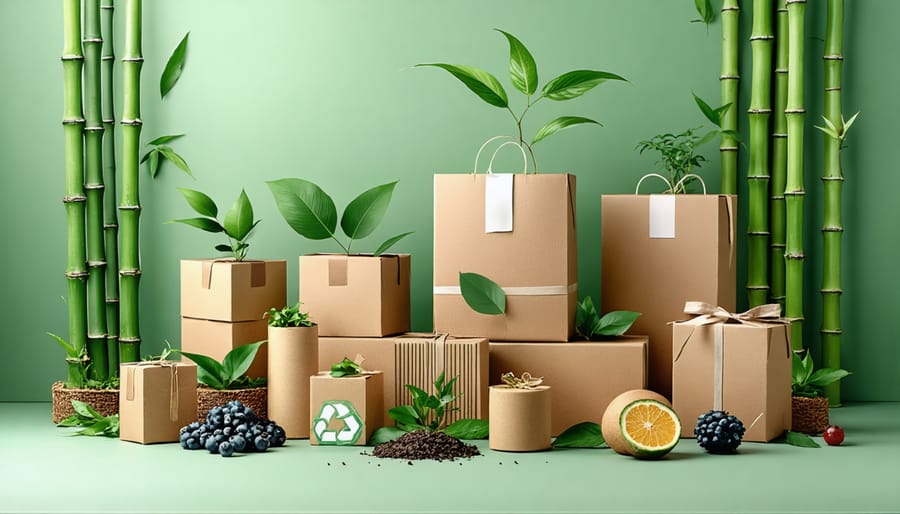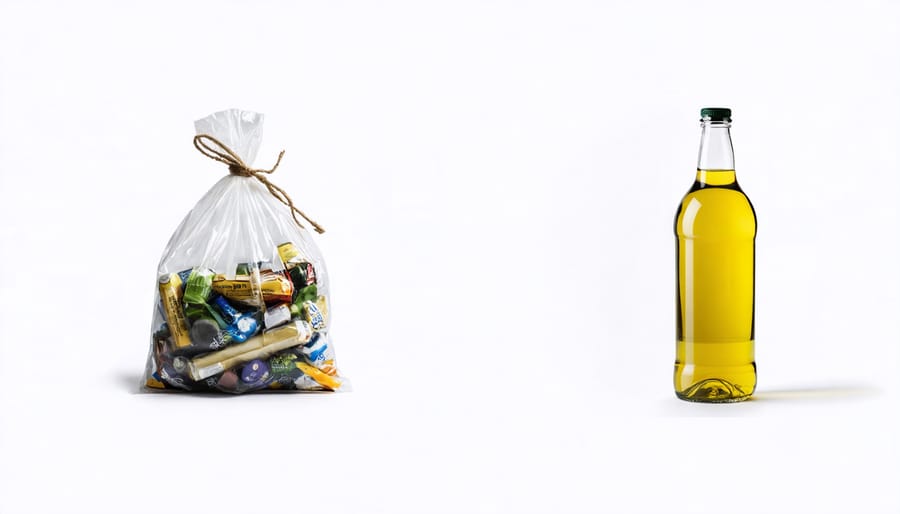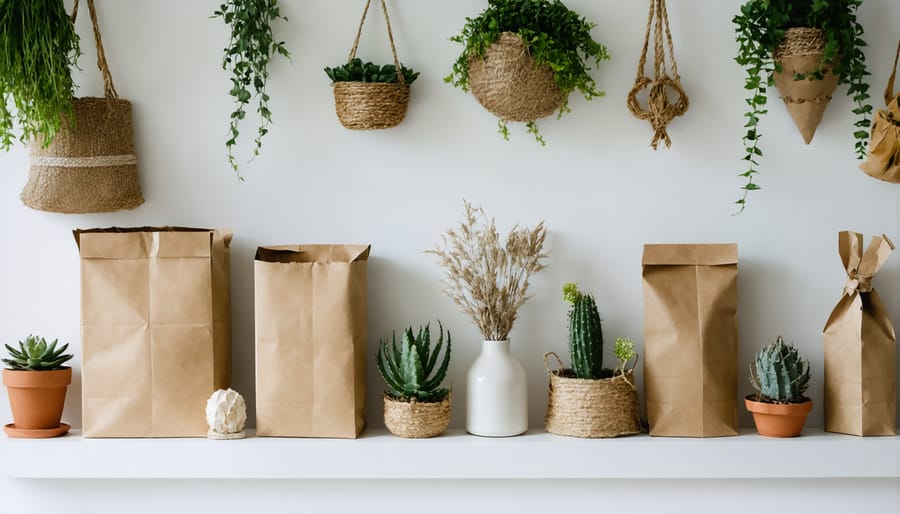Transform your product packaging with sustainable materials that benefit both the planet and your bottom line. As consumers increasingly demand eco-friendly solutions, sustainable packaging design has evolved from a niche trend to an essential business practice. By incorporating renewable materials, minimizing waste, and optimizing shipping efficiency, forward-thinking brands are revolutionizing how products reach consumers while reducing their environmental impact.
Today’s innovative packaging solutions combine biodegradable materials like mushroom-based foam, recycled cardboard, and plant-based plastics with clever structural designs that eliminate excess space and material usage. These advancements not only protect products effectively but also decompose naturally, leaving minimal environmental footprint. Smart design choices, such as modular components and multi-functional packaging that serves a second life as storage or display items, further enhance sustainability while delighting customers.
Whether you’re a small business owner looking to make the switch or a conscious consumer seeking to understand packaging impacts, embracing sustainable design principles offers clear advantages. From reduced shipping costs and enhanced brand reputation to measurable environmental benefits, eco-friendly packaging represents the future of product delivery – a future where protecting our purchases doesn’t come at the expense of protecting our planet.
Why Sustainable Packaging Matters in Home Decor
The Environmental Cost of Traditional Packaging
Traditional packaging has left a significant environmental footprint that we can no longer ignore. Each year, millions of tons of plastic packaging end up in our oceans and landfills, taking hundreds of years to decompose. The most common culprits? Single-use plastic containers, styrofoam packaging, and non-recyclable composite materials that combine different elements, making them impossible to process.
Think about your typical grocery run: plastic produce bags, cardboard boxes with plastic windows, bubble wrap, and countless layers of protective packaging. While these materials certainly keep products safe during shipping, they come at a steep environmental cost. Many conventional packaging materials require extensive energy and natural resources to produce, contributing to deforestation, greenhouse gas emissions, and water pollution.
What’s particularly concerning is that nearly 40% of plastic packaging is used just once before being discarded. The production process itself releases harmful chemicals into the environment, while improper disposal leads to microplastics in our water systems and soil. Even when traditional packaging is recyclable, the recycling process isn’t always efficient or cost-effective, leading to more waste than necessary.
Consumer Trends Driving Change
Today’s consumers are increasingly aware of environmental issues, driving significant changes in packaging design. Recent surveys show that over 70% of shoppers actively seek out eco-friendly products and sustainable packaging options. This shift in consumer behavior has prompted brands to rethink their packaging strategies.
The most notable trends include a growing preference for minimal packaging, recyclable materials, and plastic-free alternatives. Consumers are willing to pay more for products that align with their environmental values, particularly when it comes to everyday household items. They’re also becoming more educated about greenwashing, demanding genuine sustainability rather than empty eco-friendly claims.
Social media has amplified this movement, with unboxing videos highlighting excessive packaging receiving criticism while innovative, sustainable solutions gain praise. This public accountability has encouraged companies to develop creative packaging solutions that protect products while minimizing environmental impact. The rise of zero-waste stores and refill stations further demonstrates how consumer preferences are reshaping the packaging landscape.

Top Sustainable Packaging Materials for Home Products
Biodegradable Materials
When it comes to sustainable packaging, biodegradable materials are leading the charge in creating a more healthy home environment. These innovative materials naturally break down over time, leaving minimal impact on our planet. Popular options include corn-based PLA (polylactic acid), mushroom packaging, and seaweed-based materials that dissolve completely in water.
What makes these materials special is their ability to decompose naturally within months rather than centuries. For example, mushroom packaging, made from agricultural waste and fungal mycelium, breaks down in your garden within 45 days. Similarly, corn-based PLA products can be commercially composted in about 90 days under the right conditions.
Before choosing biodegradable packaging, consider these key factors:
– Composting conditions required (home vs. commercial facilities)
– Expected shelf life of your products
– Moisture resistance needs
– Cost comparison with traditional materials
For home use, look for certification labels like “home compostable” or “BPI certified” to ensure the materials will break down properly. Some excellent starter options include paper-based mailers, cardboard boxes made from recycled materials, and plant-based bubble wrap alternatives.
Remember that while these materials cost slightly more upfront, they offer significant environmental benefits and can enhance your brand’s reputation for sustainability. Just ensure you’re storing them properly to maintain their integrity before use.
Recycled and Recyclable Solutions
When it comes to sustainable packaging, recycled and recyclable materials are leading the charge in eco-friendly design. Post-consumer recycled (PCR) materials, like recycled cardboard and plastic, have proven remarkably effective in creating durable, attractive packaging while reducing environmental impact. These materials give new life to existing resources and help close the loop in our consumption cycle.
Paper-based materials remain the champions of recyclability, with corrugated cardboard boasting an impressive 96% recycling rate. What’s even better is that these materials can be recycled up to seven times before losing their structural integrity. Modern recycled plastics have also come a long way, with PET and HDPE containers now matching the quality and durability of their virgin counterparts.
For the DIY enthusiast, incorporating recycled packaging materials into your projects is surprisingly simple. Try using recycled glass jars for storage solutions or repurposing cardboard boxes into organizing systems. The key is to look for packaging marked with clear recycling symbols and instructions – this ensures proper disposal and increases the likelihood of successful recycling.
Remember that effective recycled packaging isn’t just about the material choice; it’s also about smart design. Look for minimal packaging that serves its purpose without excess bulk. The best sustainable designs consider both the beginning and end of the product’s life cycle, making it easy for consumers to either reuse or recycle the materials properly.
Innovative Natural Materials
Nature continues to inspire incredible innovations in sustainable packaging, offering eco-friendly alternatives that are both beautiful and practical. One of the most exciting developments is mushroom packaging, created from agricultural waste and mycelium (mushroom roots). This material grows into any desired shape and naturally biodegrades in your garden after use.
Another groundbreaking option is seaweed-based packaging, which dissolves in water and can even be eaten! These marine-derived materials are particularly promising because seaweed grows quickly without requiring freshwater or land resources.
Banana leaves and other plant fibers are making a comeback in modern packaging design, offering natural alternatives to plastic wrapping. These materials are particularly effective for food packaging and can be composted right in your backyard.
Agricultural waste is being transformed into sturdy packaging materials, giving new life to corn husks, wheat straw, and rice hulls. These materials would otherwise be discarded but can create durable, protective packaging that returns nutrients to the soil when disposed of.
For those interested in DIY solutions, you can experiment with making your own eco-friendly packaging using materials like pressed leaves, grass paper, or even homemade bioplastics from potato starch. These natural alternatives not only reduce environmental impact but also add a unique, artisanal touch to gifts and home-stored items.
Smart Design Features for Eco-Friendly Packaging
Minimalist Design Approaches
When it comes to sustainable packaging, less is definitely more. Following current sustainable design trends, minimalist packaging approaches focus on reducing material usage while maximizing functionality. This smart design philosophy not only helps protect our environment but also creates visually appealing packaging that resonates with modern consumers.
Consider these practical minimalist strategies that make a big impact:
First, eliminate unnecessary layers and opt for single-material solutions. Instead of combining multiple materials that make recycling difficult, choose one eco-friendly material that can do the job effectively. This might mean replacing a box-and-wrapper combo with a simple, well-designed box.
Shape optimization is another key approach. By carefully analyzing the product’s dimensions, designers can create packaging that fits perfectly without excess space or material. Think about how tech companies have mastered this – modern smartphone boxes are precisely sized, using minimal materials while still protecting the device.
Smart structural design can eliminate the need for additional protective elements. Clever folding techniques and strategic scoring can create built-in cushioning and support, reducing the need for extra padding or inserts. This approach not only saves materials but often results in more elegant packaging solutions.
Color and printing choices matter too. Limiting ink usage and choosing eco-friendly printing methods can significantly reduce the environmental impact. Many brands now embrace simple, one or two-color designs that look sophisticated while minimizing resource consumption.
Remember, effective minimalist packaging isn’t just about using less – it’s about using materials more intelligently to create sustainable solutions that work better for everyone.

Multi-Use Packaging Solutions
Transform your eco-friendly packaging into stunning home decor pieces with these creative repurposing ideas. Glass jars from pasta sauce or pickles can become elegant vases, bathroom organizers, or stylish storage containers for pantry staples. Simply remove the labels, clean thoroughly, and consider painting the lids in coordinating colors for a cohesive look.
Sturdy cardboard boxes, especially those with interesting patterns or textures, can be transformed into decorative storage solutions. Cover them with fabric or paper, add some decorative elements, and use them to organize everything from craft supplies to seasonal decorations. Large shipping boxes can be converted into practical toy storage units or magazine holders when properly reinforced and decorated.
Metal tins and containers offer endless possibilities. Paint them with chalk paint for a vintage look, add some distressing, and use them as planters or desk organizers. Coffee cans make excellent pencil holders or small tool organizers when decorated with rope, fabric, or paint.
Consider turning wine bottles into statement pieces by adding fairy lights inside for ambient lighting, or create a modern vase collection by painting them in metallic finishes. Even simple paper bags can be transformed into rustic wall art or gift wrap with some creative stamping and painting.
Remember to thoroughly clean all packaging before repurposing, and always ensure any sharp edges are properly smoothed. For food-related reuse, stick to containers that originally held food products. By giving packaging a second life, you’re not only reducing waste but also creating unique, personalized decor elements that tell a story in your home.

Making the Switch: Practical Tips for Consumers
Making the switch to sustainable packaging doesn’t have to be overwhelming. As more consumers embrace environmentally conscious solutions, manufacturers are offering increasingly accessible options. Here are some practical tips to help you make better packaging choices in your daily life:
Start by becoming a mindful shopper. Look for products with minimal packaging or those using recycled materials. Many brands now clearly label their packaging with recycling symbols and material information – take a moment to learn what these mean and choose accordingly.
Consider bulk shopping as an excellent way to reduce packaging waste. Bring your own reusable containers to stores that offer bulk bins for dry goods, personal care items, and cleaning products. This not only reduces waste but often saves money too.
When shopping online, try consolidating your orders to reduce shipping materials. Many retailers now offer “frustration-free” packaging options or allow you to request minimal packaging – don’t hesitate to select these options when available.
Get creative with reusing packaging materials that come into your home. Glass jars can become storage containers, shipping boxes can be used for organization, and paper packaging can be composted or recycled. Before recycling, always check if items can serve another purpose.
Look for products with innovative packaging solutions, such as:
– Compostable materials
– Plant-based packaging
– Refillable containers
– Concentrated products that use less packaging
– Multi-use packaging that serves a secondary purpose
Remember to properly clean and separate materials before recycling. Many communities have specific guidelines for recycling different types of packaging – familiarize yourself with local requirements to ensure your efforts make a real impact.
Start small and build sustainable habits gradually. Every mindful choice contributes to reducing packaging waste and creating a more sustainable future.
As we’ve explored, sustainable packaging design isn’t just a trend – it’s a crucial step toward a greener future. By choosing eco-friendly materials, minimizing waste, and embracing innovative designs, we can all contribute to environmental conservation while creating beautiful, functional packaging solutions. Remember that every sustainable choice, no matter how small, makes a difference. Whether you’re a DIY enthusiast working on home projects or simply looking to make more environmentally conscious decisions, implementing these packaging principles can help reduce your environmental footprint. Start with one change today, such as switching to recyclable materials or reducing package size, and build from there. Together, we can create a more sustainable future through thoughtful packaging design choices that benefit both our homes and our planet.
